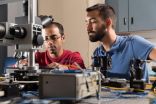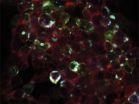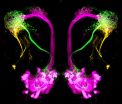(Press-News.org) NEW YORK, NY -- Researchers at NYU Langone Medical Center have developed new technology that can assess the location and impact of a brain injury merely by tracking the eye movements of patients as they watch music videos for less than four minutes, according to a study published Friday on-line in the Journal of Neurosurgery.
The study suggests that the use of eye tracking technology may be a potential biological marker for assessing brain function and monitoring recovery for patients with brain injuries.
Led by Uzma Samadani, MD, PhD, chief of neurosurgery at New York Harbor Health Care System and co-director of the Steven & Alexandra Cohen Veterans Center for the Study of Post-Traumatic Stress and Traumatic Brain Injury at NYU Langone, the study looked at 169 veterans; 157 of whom were neurologically healthy and 12 who either had known weaknesses in the nerves that move the eyes, or brain swelling adjacent to those nerves. These nerves affect how the eye moves up and down and side to side.
Using a technology developed at NYU Langone, the investigators had the participants watch a music video or television content for 220 seconds while they measured the ratio of horizontal to vertical eye movements. They discovered that in the neurologically healthy subjects, the ratios were close to one-to-one, with horizontal movements equaling vertical movements. But the 12 participants with nerve damage or swelling in the brain pressing on nerves all showed abnormal eye movement ratios correlating to the nerve that was affected. In every case where the abnormal eye movement was due to swelling in the brain, surgery to fix the brain problem also restored the eye movements to normal range.
"We are very excited about the findings because it offers a proof of concept that this technology can detect brain injury and suggest its location," says Dr. Samadani. "One of the reasons that clinical trials for treatment of brain injury have failed in the past is that brain injury is hard to classify and quantitate with existing technologies. This invention suggests a potential new method for classifying and quantitating the extent of injury. Once validated, it will both accelerate diagnosis and aid in the development of better treatments."
Commenting on the study, Charles Marmar, MD, the Lucius Littauer professor and chairman of Psychiatry at NYU Langone, and executive director of NYU Langone's Steven & Alexandra Cohen Veterans Center (which helps fund Dr. Samadani's research), says: "These results are extremely exciting because the technology is not overly complicated and, as a result, can move from the bench to the battlefield and other places where it will be easily accessible to all."
Dr. Marmar added that because of its easy usability, it can be applied, for example, to study hundreds of subjects in a relatively short period of time. He pointed in particular to recent eye-tracking work led by Dr. Samadani of over 600 active military at Fort Campbell in Kentucky, who were assessed with this technology in the first week after they returned home from their deployment. "These studies will help further evaluate the technology's effectiveness as a screening tool," he adds.
Brain injury is the number one cause of death and disability in Americans under age 35, According to the U.S. Centers for Disease Control and Prevention. Every year, 1.4 million people suffer from a traumatic brain injury in the United States. Of those, 50,000 die and 235,000 require hospital admission.
While the paper describes patients with brain problems that are apparent on imaging, Dr. Samadani says the technology will likely be most useful for the assessment of concussion and blast injury - which can be difficult to detect with standard imaging studies, and which is highly prevalent among returning veterans from the long Middle East wars. "Because eye tracking measures how well the brain functions rather than assesses what it looks like, it provides very different information than imaging studies" she says.
It may also be helpful for triage. "When a person falls and hits their head, it can be difficult to determine whether the injury is life-threatening," Dr. Samadani says. "Eye tracking is potentially a simple, non-invasive and cost-effective way to determine quickly which patients need immediate attention."
INFORMATION:
In addition to Dr. Samadani, co-authors of this study include Sameer Farooq; Robert Ritlop, MEng.; Floyd Warren, MD; Marleen Reyes, BA; Elizabeth Lamm, BA; Anastasia Alex, BS; Elena Nehrbass, BS; Radek Kolecki, BS; Michael Jureller, BS; Julia Schneider; Agnes Chen, BA; Chen Shi, BS; Neil Mendhiratta, BA; Jason H. Huang, MD; Meng Qian, PhD; Roy Kwak, MD; Artem Mikheev, MS; Henry Rusinek, PhD; Ajax Goerge, MD; Robert Fergus, PhD; Douglas Kondziolka, MD; Paul P. Huang, MD; and Theodore Smith, Md, PhD.
Dr. Samadani's research is supported in part by the U.S. Department of Veterans Affairs (VA), Veterans Health Administration, Office of Research and Development, Rehabilitation and Research and Development Service via a VA Merit Award (1I01RX000319-01); a Career Development Award from the American College of Surgeons/Neurosurgery Research Education Foundation of the AANS; the Steven & Alexandra Cohen Veterans Center for the Study of Post-Traumatic Stress and Traumatic Brain Injury; The Thrasher Research Fund; and Research to Prevent Blindness.
GALVESTON, Texas -- In the largest study to date evaluating outcomes of Hispanic women with endometrial uterine cancer, researchers at the University of Texas Medical Branch at Galveston have found that Hispanic women in the United States were significantly less likely to survive the cancer than non-Hispanic white women.
A total of 69,764 women diagnosed with endometrial cancer between 2000 and 2010 were included in this study of public-use data from the National Cancer Institute's Surveillance, Epidemiology, and End Results Program. The study is available online in the ...
A team of researchers from the University of California, San Diego have demonstrated a way to emit and control quantum light generated using a chip made from silicon--one of the most widely used materials for modern electronics.
The UC San Diego researchers recently described their new device's performance online in the journal Nature Communications, available via Open Access .
The researchers say practical applications of quantum optics will seem more feasible if devices for generating and controlling these photons can be manufactured using conventional materials ...
It's the most basic of ways to find out what something does, whether it's an unmarked circuit breaker or an unidentified gene -- flip its switch and see what happens. New remote-control technology may offer biologists a powerful way to do this with cells and genes.
A team at Rockefeller University and Rensselaer Polytechnic Institute is developing a system that would make it possible to remotely control biological targets in living animals -- rapidly, without wires, implants or drugs.
Today (December 15) in the journal Nature Medicine, the team describes successfully ...
BOSTON (Dec. 16, 2014) -- Extra vitamin E protected older mice from a bacterial infection that commonly causes pneumonia. Microbiologists and nutrition researchers from Tufts University report that the extra vitamin E helped regulate the mice's immune system. The findings, published online in advance of print in the The Journal of Immunology, show promise for studies investigating the effects of vitamin E and infection in humans.
Older adults over age 65 are at high risk for developing pneumonia, an inflammation of the lungs typically caused by infection. The most common ...
A scientific team at UBC and Providence Health Care have genetically engineered mice with less wrinkled skin, despite repeated exposure to wrinkle-inducing ultraviolet (UV) light.
The youthful-looking mice were bred without the gene that produces Granzyme B, an enzyme that immune cells use to destroy harmful pathogens. The UBC-Providence team, led by Professor David Granville and postdoctoral fellow Leigh Parkinson, found that Granzyme B also does harm: When produced and released by skin cells in response to UV light, it triggers the breakdown of collagen, a structural ...
ANN ARBOR--A set of eight hurricane-forecast satellites being developed at the University of Michigan is expected to give deep insights into how and where storms suddenly intensify--a little-understood process that's becoming more crucial to figure out as the climate changes, U-M researchers say.
The Cyclone Global Navigation Satellite System is scheduled to launch in fall 2016. At the American Geophysical Union Meeting in San Francisco this week, U-M researchers released estimates of how significantly CYGNSS could improve wind speed and storm intensity forecasts.
CYGNSS--said ...
Contrary to popular belief, new research suggests that some employees adapt well to pressures caused by changes in the workplace.
Pay cuts, reduced working hours, fewer training and promotion opportunities are just a few of the measures organisations employ to combat economic downturn and industry competition. Where previous research has suggested cut backs result in a demotivated and unhappy workforce, experts from Monash University and The University of Iowa say this might not necessarily be the case.
A new study published in the Journal of Occupational and Organizational ...
A global fleet of composite planes could reduce carbon emissions by up to 15 percent, but the lighter planes alone will not enable the aviation industry to meet its emissions targets, according to new research.
The study, by the Universities of Sheffield, Cambridge and UCL (University College London), is the first to carry out a comprehensive life cycle assessment (LCA) of a composite plane, such as the Boeing Dreamliner 787 or Airbus 350, and extrapolate the results to the global fleet.
The LCA covers manufacture, use and disposal, using publicly available information ...
A team of Chinese and Italian scientists has joined efforts to provide a key to the understudied phaleratus group of blister beetles. During their research the scientists have also discovered a new species from the genus Hycleus, which they named after Marco Polo, as a tribute to their collaboration during the Ph.D. studies. The study was published in the open access journal ZooKeys.
The phaleratus group to which the new species Hycleus marcipoli belongs, is part of the Meloidae family commonly known as the blister beetle family. The representatives of this group get ...
This news release is available in German. Whether an odor is pleasant or disgusting to an organism is not just a matter of taste. Often, an organism's survival depends on its ability to make just such a discrimination, because odors can provide important information about food sources, oviposition sites or suitable mates. However, odor sources can also be signs of lethal hazards. Scientists from the BMBF Research Group Olfactory Coding at the Max Planck Institute for Chemical Ecology in Jena, Germany, have now found that in fruit flies, the quality and intensity of ...





